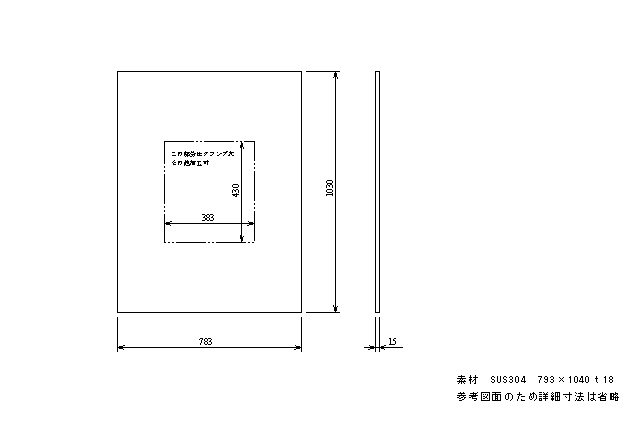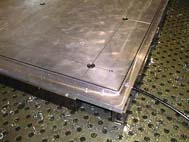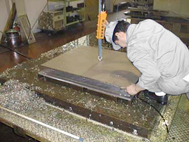| Data name |
| @Plane cutting of large stainless steel plate by vacuum chuck. |
| Overview |
| @This process involves cutting aplate of stainless steel (783~103018jon both sides, and finishing the plate thickness to 15mm}0.1. @Production number 4 to 6/half a year. |
 |
| Point |
| @Clamp chattering and processing distortion were solved by vacuum chuck,
and machining accuracy was enhanced. ESUS304 |
| Result |
| @There was no clamping, strain or chattering at all. The processing was completed with the accuracy of 20Κ or less in the thickness, and 0.15 or less in the flatness. |
| Commentary |
| @At our company, when machining such work, we use the screw/seat grill hole in the place where it is scraped, or weld the clamp piece to the outer circumference, thenl finish again after processing. @This time, the main material was sucked by the vacuum chuck, and as a supplement, stopped using 4 M6 bolts. Since the absorptive power is about 6 t, considerably heavy cutting is possible, but since the material is stainless steel, processing strain occurs. So, the cutting was done, first with rough cutting of 0.3mm, and then, with 0.2mm finishing. It took 1 to 4 times per side to be completed. @The machining distortion was 3 to 4mm at the outer circumfernce after cutting the first side. After that, it alternately became smaller each time, but became concave on the cutting surfadce. The first distortion seems to have occurred largely because one side of the internal stress of the material was released. Although, this work involves processing about 20 sheets, the distortions that occur are not constant at present. We believe this is due to variations in the amount of internal stress of the material and the sharpness of the cutter. In this work, the number of finishing times was judged by the amount of distortion with the remaining milling allowance of 1mm. @In the workpiece, screws of M12 were machined, and the work was suspended using the eyebolt at the time of attaching and detaching. |
| Comment |
| @When using avacuum chuck with a milling/ machining center, In most cases, the mounting base is specifically designed for the workpiece. @Since the clamping force of the vacuum chuck, when appliend in horizontal direction, is about 35 of the clamping force compared to the vertical direction, 4 stoppers are made in the X.Y direction of the M6 bolts in the base. @Neoprene sponge round cord was used as the O-ring for leak prevention. Toyoron hose was used for the line between the vacuum unit and the base. |
    Base setting. Cutting. Finishing. |